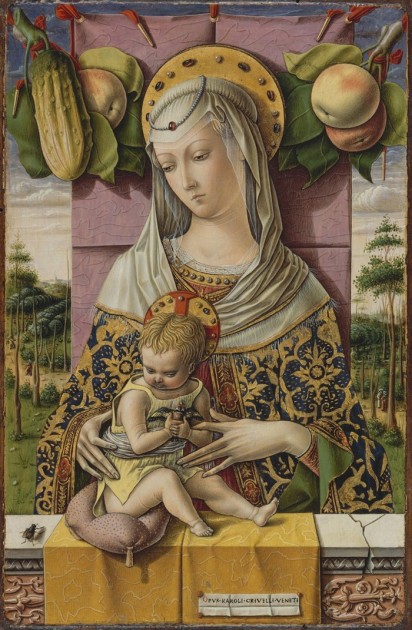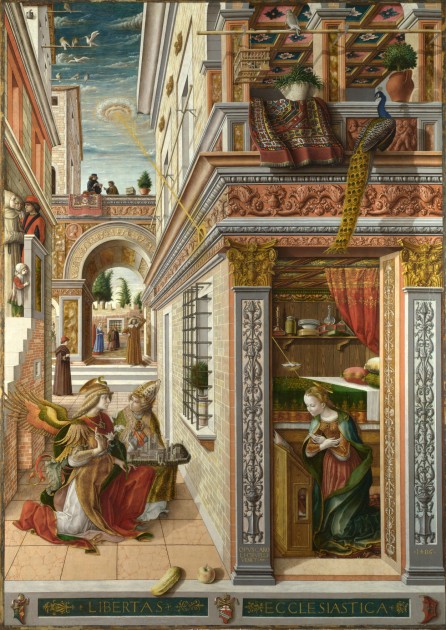Tuesday, January 8th, 2019
Crevelli’s Cucumbers, Christ, and Cotán
I am reading the most wonderful book right now, The Art of Reading: An Illustrated History of Books in Paint, which was just published last year. Thus far it has helped the post-holiday “January blues” to feel more manageable. This is a book that I wish I would have written myself. For the past few years, I have been less interested in the things that I studied in graduate school, and personally feel drawn to just looking at images of people reading books. I suppose these images serve as my escape, since I wish I had more quiet moments alone that I could spend reading for pleasure.
What caught my attention last night, though, was a tangential mention of a cucumber in the painting The Annunciation , with Saint Emidius (1486, shown below) by the Venetian painter Carlo Crivelli.1 While books to appear in this painting (which ties into the purpose for its inclusion in my new book), I think the most striking thing is the cucumber that is prominently displayed in the foreground, balanced on a ledge and projecting toward the viewer.
The book says that the cucumber is a symbol of resurrection and redemption, and the Metropolitan Museum of Art also supports this connection with redemption. An audio interview with food writer Gillian Riley, embedded on the National Gallery webpage for the painting, more generally says that the cucumber is a symbol for Christ.
But why would cucumbers be seen in this way? This definitely is not a common symbol in Renaissance art, or even Christian art for that matter. Crivelli used the motif often in his art, so much that it has been called his “signature motif.” So far, I’ve only found some amusing and snarky speculation. And I’m afraid this post is just more speculation. I wonder if this conclusion has been determined by the context that Crivelli creates within his paintings: the cucumber appears over the head of the dead Christ in Crivelli’s The Dead Christ With the Virgin, St. John and St. Mary Magdalene (shown below). In this painting, the angle of Christ’s limp head is has the same position and directional movement as the cucumber in the garland above, suggesting a visual and symbolic relationship between the two.
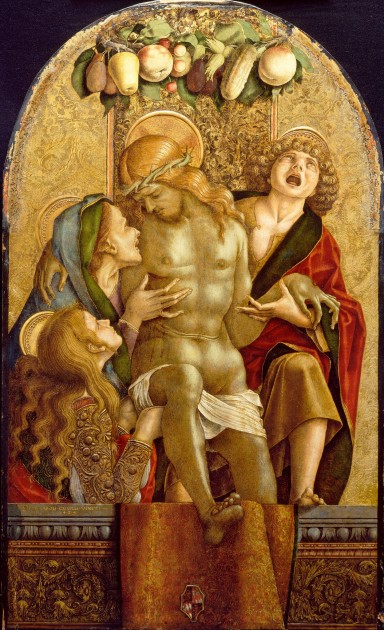
Crivelli, “The Dead Christ With the Virgin, St. John and St. Mary Magdalene,” 1485 (Museum of Fine Arts, Boston)
In The Annunciation, with Saint Emidius and Madonna and Child ( shown at the top of the post), the cucumber is placed next to one or more apples. The apple is commonly depicted as the Forbidden Fruit from the Garden of Eden, and therefore serves as a symbol of sin. Perhaps this context helps us to know that the cucumber, then, symbolically is a reversal of the apple.
The cucumber and the apple also have different shapes too, and I think it is also in the realm of possibility to think of them in gendered terms. The round apple has been connected with female breasts in the past (even within the context of the Forbidden Fruit and Eve).2 Perhaps the cucumber was intended to serve as a symbol of Christ in a very physical way. Perhaps Leo Steinberg would have liked this idea? I think that Elizabeth Honig might agree that the phallic connotations would have been possible, she noted something similar in sixteenth-century art, although admittedly for a Northern context.3
One thing that I would like to determine, though, is whether the seventeenth-century painter Juan Sánchez Cotán might have somehow been influenced by Crivelli’s composition. Cotán’s still life that includes a cucumber has a very similar composition to Crivelli’s one in the Annunciation, with both of the cucumbers placed right in the foreground on a ledge. Both paintings also have a similar interest in illusionism with a strong shadow that falls to the right.
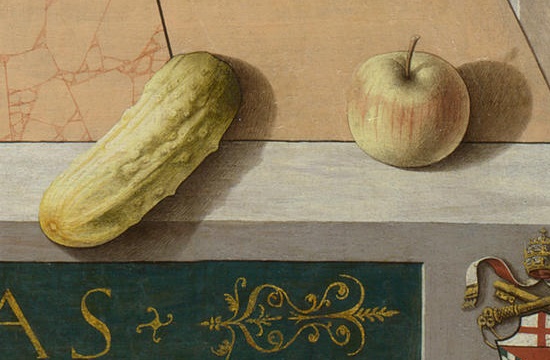
Carlo Crivelli, Detail of cucumber and apple from “The Annunciation, with Saint Emidus,” 1486 (National Gallery)
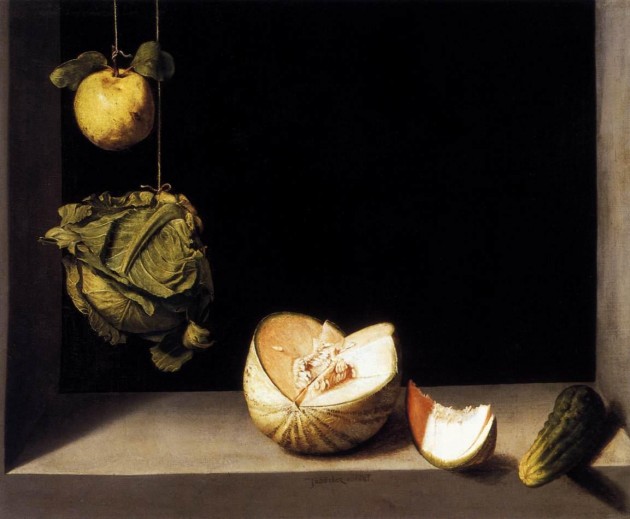
Juan Sánchez Cotán, “Quince, Cabbage, Melon, and Cucumber,” 1602, oil on canvas, 68.9 cm x 84.5 cm (San Diego Museum of Art)
Could it be that the Hapsburg Spanish presence in Italy somehow allowed for knowledge of Crivelli’s art to reach Cotán in Spain? Perhaps it is a stretch, but it would be interesting if a connection could be made! Any ideas? It is interesting to think about the cucumber and resurrection in this context too, since the other fruits and vegetables positioned in a way to suggest ascension and descension, depending on the direction the viewer’s eye moves horizontally across the picture plane.
Does anyone else have thoughts on cucumbers in art? When I first read about cucumbers as a symbol of resurrection, I jokingly wrote on Twitter that I hoped it was because the cucumber descends into a tomb of brine and re-emerges with a new life as a pickle. Alas, it doesn’t look like that is the case!
1 Jamie Camplin and Maria Ranauro,The Art of Reading: An Illustrated History of Books in Paint (Los Angeles: Getty Publications, 2018), p. 26
2 I’m specifically thinking of the Hildesheim doors, in which even holds an apple from the forbidden Tree of Knowledge of Good and Evil over her chest, as if it is a breast. This is discussed in Adam S. Cohen and Anne Derbes, “Bernward and Eve at Hildesheim,” Gesta (vol. 40, no 1): 2001, 24.
3 Elizabeth Honig, Painting and the Market in Early Modern Antwerp (Yale University Press, 1999), 43.
